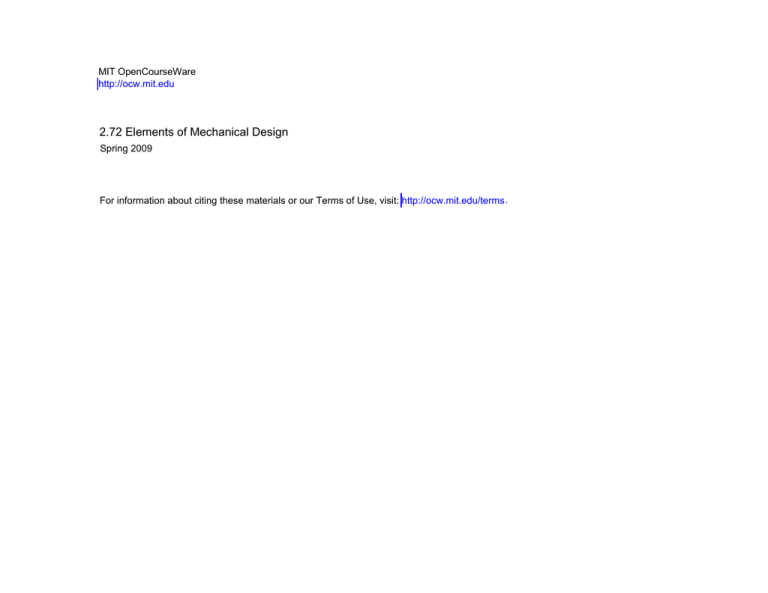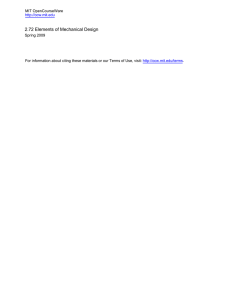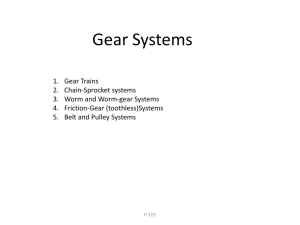
MIT OpenCourseWare
http://ocw.mit.edu
2.72 Elements of Mechanical Design
Spring 2009
For information about citing these materials or our Terms of Use, visit: http://ocw.mit.edu/terms.
2.72
Elements of Mechanical Design
Lecture 12:
Belt, friction, gear drives
Schedule and reading assignment
Quiz
Bolted joint qualifying Thursday March 19th
Topics
Belts
Friction drives
Gear kinematics
Reading assignment
• Read:
14.1 – 14.7
• Skim:
Rest of Ch. 14
© Martin Culpepper, All rights reserved
2
Topic 1: Belt Drives
© Martin Culpepper, All rights reserved
3
Belt Drives
Why Belts?
Torque/speed conversion
Cheap, easy to design
Easy maintenance
Elasticity can provide damping, shock absorption
Image by dtwright on Flickr.
Keep in mind
Speeds generally 2500-6500 ft/min
Performance decreases with age
Images removed due to copyright restrictions.
Please see:
Image by v6stang on Flickr.
http://www.tejasthumpcycles.com/Parts/primaryclutch/3.35-inch-harley-Street-Belt-Drive.jpg
http://www.al-jazirah.com.sa/cars/topics/serpentine_belt.jpg
© Martin Culpepper, All rights reserved
4
Belt Construction and Profiles
Many flavors
Flat is cheapest, natural clutch
Vee allows higher torques
Synchronous for timing
Usually composite structure
Rubber/synthetic surface for friction
Steel cords for tensile strength
© Martin Culpepper, All rights reserved
5
Belt Drive Geometry
Driven Pulley
Slack Side
d2
ω1
d1
Driving
Pulley
© Martin Culpepper, All rights reserved
ω2
vbelt
Tight Side
6
Belt Drive Geometry
θ2
θ1
dspan
dcenter
© Martin Culpepper, All rights reserved
7
Contact Angle Geometry
θ2
d2
θ1
ω1 d1
ω2
dspan
dcenter
⎛ d2 −d1 ⎞
⎟⎟
θ1 = π −2sin ⎜⎜
⎝ 2dcenter ⎠
−1
© Martin Culpepper, All rights reserved
⎛ d2 −d1 ⎞
⎟⎟
θ2 = π +2sin ⎜⎜
⎝ 2dcenter ⎠
−1
8
Belt Geometry
θ2
d2
θ1
ω1 d1
ω2
dspan
dcenter
⎛ d2 −d1 ⎞
−⎜
⎟
⎝ 2 ⎠
2
dspan = d
2
center
© Martin Culpepper, All rights reserved
Lbelt = 4d
2
center
− (d2 −d1 ) + 1 (d1θ1 +d2θ2 )
2
2
9
Drive Kinematics
θ2
d2
θ1
ω1 d1
ω2
dspan
dcenter
d1
d2
vb = ω1 = ω2
2
2
© Martin Culpepper, All rights reserved
d1 ω2
=
d 2 ω1
10
Elastomechanics
Elastomechanics → torque transmission
Kinematics → speed transmission
Link belt preload to torque transmission
Proceeding analysis is for flat/round belt
Driven
Pulley
Slack Side
d2
ω1
d1
Driving
Pulley
© Martin Culpepper, All rights reserved
ω2
vbelt
Tight Side
11
Free Body Diagram
y
x
dS
F
μdN
F+dF
dN
d/2
•Tensile force (F)
•Normal force (N)
•Friction force (μN)
dθ
•Centrifugal force (S)
© Martin Culpepper, All rights reserved
12
Force Balance
y
dS
x
F
Using small angle approx:
μdN
F+dF
dN
d/2
dθ
dθ
dθ
ΣFy = 0 = −(F + dF ) − F
+ dN + dS
2
2
Fdθ = dN + dS
ΣFx = 0 = −μdN − F + (F + dF )
μdN = dF
© Martin Culpepper, All rights reserved
13
Obtaining Differential Eq
y
dS
x
F
Let m be belt mass/unit length
μdN
2
F+dF
dN
d/2
⎛d ⎞ 2
dS = m⎜ ⎟ ω dθ
⎝ 2⎠
Combining these red eqns:
2
dθ
⎛d ⎞
dF = μFdθ − μm⎜ ⎟ ω 2 dθ
⎝2⎠
2
dF
⎛d ⎞
− μF = − μm⎜ ⎟ ω 2
dθ
⎝2⎠
© Martin Culpepper, All rights reserved
14
Belt Tension to Torque
Let the difference in tension between the loose side (F2) and the
tight side (F1) be related to torque (T)
T
F1 − F2 =
d
2
F1
Solve the previous integral over contact angle and apply F1 and
F2 as b.c.’s and then do a page of algebra:
T
μθcontact
Te
+1
Ftension = μθcontact
de
−1
2e μθcontact
⎛d ⎞ 2
F1 = m⎜ ⎟ ω + Ftension μθcontact
e
+1
⎝2⎠
F2
2
2
2
⎛ d ⎞ 2
F2 = m⎜ ⎟ ω + Ftension μθcontact
e
+1
⎝2⎠
© Martin Culpepper, All rights reserved
Used to find stresses
in belt!!!
15
Practical Design Issues
Pulley/Sheave profile
Which is right?
Manufacturer → lifetime eqs
Belt Creep (loss of load capacity)
Lifetime in cycles
A
B
C
Idler Pulley Design
Catenary eqs → deflection to tension
Large systems need more than 1
Idler
IDL
ALT
P/S
Water
pump
& fan
Idler
Crank
Images by v6stang on Flickr.
© Martin Culpepper, All rights reserved
Figure by MIT OpenCourseWare.
16
Practice problem
Delta 15-231 Drill Press
1725 RPM Motor (3/4 hp)
450 to 4700 RPM operation
Assume 0.3 m shaft separation
What is max torque at drill bit?
What size belt?
Roughly what tension?
© Martin Culpepper, All rights reserved
Images removed due to copyright restrictions. Please see
http://www.rockler.com/rso_images/Delta/15-231-01-500.jpg
17
Topic 2: Friction Drives
© Martin Culpepper, All rights reserved
18
Friction Drives
Why Friction Drives?
Linear ↔ Rotary Motion
Low backlash/deadband
Can be nm-resolution
Images removed due to copyright restrictions. Please see
http://www.beachrobot.com/images/bata-football.jpg
http://www.borbollametrology.com/PRODUCTOS1/Wenzel/
WENZELHorizontal-ArmCMMRSPlus-RSDPlus_files/rsplus.jpg
Keep in mind
Preload → bearing selection
Low stiffness and damping
Needs to be clean
Low drive force
© Martin Culpepper, All rights reserved
19
Friction Drive Anatomy
Motor and
Transmission/Coupling
Drive Roller
Drive Bar
Concerned with:
•Linear Resolution
•Output Force
•Max Roller Preload
Backup
Rollers
•Axial Stiffness
© Martin Culpepper, All rights reserved
20
Drive Kinematics/Force Output
Kinematics found from no slip cylinder on flat
Δδ bar
d wheel
= Δθ ⋅
2
dwheel
Δθ
vbar
d wheel
= ωwheel
2
Δδ
Force output found from static analysis
Either motor or friction limited
Foutput
© Martin Culpepper, All rights reserved
2Twheel
=
d wheel
where Foutput ≤ μFpreload
21
Maximum Preload
⎛ 1 −ν
1 −ν
⎜
Ee = ⎜
+
Ebar
⎝ Ewheel
2
wheel
2
bar
Variable Definitions
⎞
⎟⎟
⎠
−1
⎛
⎞
⎜ 1
1 ⎟
+
Re = ⎜
⎟
d
r
⎜ wheel
crown ⎟
2
⎝
⎠
−1
⎛ 3Fpreload Re ⎞
⎟⎟
acontact = ⎜⎜
⎝ 2Ee ⎠
For metals:
τ max =
3σ y
2
1
3
Shear Stress Equation
acontactEe ⎛ 1 + 2ν wheel 2
⎞
τ wheel =
+ ⋅ (1 +ν wheel ) ⋅ 2(1 +ν wheel ) ⎟
⎜
2πRe ⎝
2
9
⎠
Fpreload , max =
3
Re
2
16π 3τ max
⎞
⎛ 1+ 2ν wheel 2
3E ⎜
+ ⋅ (1+ ν wheel ) ⋅
2(1+ ν wheel ) ⎟
2
9
⎠
⎝
3
2
e
© Martin Culpepper, All rights reserved
22
Axial Stiffness
⎛
⎜
1
1
1
1
⎜
kaxial =
+
+
+
⎜ kshaft ktorsion ktangential kbar
⎜
2
d
wheel
⎝
⎞
⎟
⎟
⎟
⎟
⎠
−1
4ae Ee
ktangential =
(2 −ν )(1+ν )
k shaft =
k torsion =
k bar =
© Martin Culpepper, All rights reserved
3π Ed
4
shaft
3
4L
4
π Gd wheel
32 L
EA c , bar
L
23
Friction Drives
Proper Design leads to
Pure radial bearing loads
Axial drive bar motion only
Drive performance linked to motor/transmission
Torque ripple
Angular resolution
Images removed due to copyright restrictions. Please see
http://www.borbollametrology.com/PRODUCTOS1/Wenzel/WENZELHorizontal-ArmCMMRSPlus-RSDPlus_files/rsplus.jpg
© Martin Culpepper, All rights reserved
24
Topic 3:
Gear Kinematics
© Martin Culpepper, All rights reserved
25
Gear Drives
Why Gears?
Torque/speed conversion
Can transfer large torques
Can run at low speeds
Large reductions in small package
Image from robbie1 on Flickr.
Keep in mind
Requires careful design
Attention to tooth loads, profile
Image from jbardinphoto on Flickr.
Images removed due to copyright restrictions. Please see
http://elecon.nlihost.com/img/gear-train-backlash-and-contact-pattern-checking.jpg
http://www.cydgears.com.cn/products/Planetarygeartrain/planetarygeartrain.jpg
© Martin Culpepper, All rights reserved
26
Gear Types and Purposes
Spur Gears
Parallel shafts
Simple shape → easy design, low $$$
Tooth shape errors → noise
No thrust loads from tooth engagement
Helical Gears
Gradual tooth engagement → low noise
Shafts may or may not be parallel
Thrust loads from teeth reaction forces
Tooth-tooth contact pushes gears apart
Images from Wikimedia Commons, http://commons.wikimedia.org
© Martin Culpepper, All rights reserved
27
Gear Types and Purposes
Bevel Gears
Connect two intersecting shafts
Straight or helical teeth
Worm Gears
Low transmission ratios
Pinion is typically input (Why?)
Teeth sliding → high friction losses
Rack and Pinion
Rotary ↔ Linear motion
Helical or straight rack teeth
Images from Wikimedia Commons, http://commons.wikimedia.org
Pinion, m2
F (t)
+
a
b
k
Figure by MIT OpenCourseWare.
© Martin Culpepper, All rights reserved
k
Rack, m1
Viscous damping, c
Rack & Pinion
28
Tooth Profile Impacts Kinematics
Want constant speed output
Conjugate action = constant angular velocity ratio
Key to conjugate action is to use an involute tooth profile
Output speed of gear train
“Real” involute/gear
“Ideal” involute/gear
ωout, [rpm]
Non or poor involute
time [sec]
© Martin Culpepper, All rights reserved
29
Instantaneous Velocity and Pitch
Model as rolling cylinders (no slip condition):
v v v v v
v = ω1 × r1 = ω2 × r2
ω1 r2
=
ω 2 r1
Model gears as two pitch circles
Contact at pitch point
Pitch Circles Meet @ Pitch Pt.
r1
r2
ω2
r1
r2
ω2
ω1
ω1
v
© Martin Culpepper, All rights reserved
30
Instantaneous Velocity and Pitch
Meshing gears must have same pitch
-Ng = # of teeth, Dp = Pitch circle diameter
Diametral pitch, PD:
Circular pitch, PC:
© Martin Culpepper, All rights reserved
PD =
PC =
Ng
Dp
πD p
Ng
π
=
PD
31
Drawing the Involute Profile
•Gear is specified by
diametral pitch and
pressure angle, Φ
Pitch Point
Φ
Pitch Circle
Base Circle
Images from Wikimedia Commons, http://commons.wikimedia.org
DB/2
DP/2
Image removed due to copyright restrictions. Please see
http://upload.wikimedia.org/wikipedia/commons/c/c2/Involute_wheel.gif
DB = DP cos Φ
© Martin Culpepper, All rights reserved
32
Drawing the Involute Profile
Pitch Point
Pitch Circle
L3
L2
3
DB
Δθ
Ln = n
2
2
1
L1
Base Circle
DB/2
© Martin Culpepper, All rights reserved
33
Transmission Ratio for Serial Gears
Gear train
Power in: Tin y ωin
Transmission ratio for elements in series:
From pitch equation: P1 =
Power out: Tout y ωout
ωout
TR = ( proper sign ) ⋅
ωin
N1 N 2
=
= P2
D1 D 2
D1 N1 ω2
=
=
D 2 N 2 ω1
11
2
For Large Serial Drive Trains:
Productof drivingteeth
TR = ( proper sign) ⋅
Productof driven teeth
© Martin Culpepper, All rights reserved
34
Transmission Ratio for Serial Gears
TR = ( proper sign ) ⋅
Serial trains:
Example 1:
Product of driving teeth
Product of driven teeth
TR = ?
in
out
Example 2:
driven
drive
driven
drive
TR = ?
driven
drive
in
© Martin Culpepper, All rights reserved
out
35
Transmission Ratio for Serial Gears
Example 3: Integral gears in serial gear trains
What is TR? Gear 1 = input and 5 = output
Product of driving teeth
TR = ( proper sign ) ⋅
Product of driven teeth
Gear - 1
N1 = 9
5
4
Gear - 2
N2 = 38
2
Gear - 3
N3 = 9
1
Gear - 4
N4 = 67
Gear - 5
N5 = 33
© Martin Culpepper, All rights reserved
3
36
Planetary Gear Trains
Planetary gear trains are very common
Very small/large TRs in a compact mechanism
Terminology:
Ring
gear
Planet
Arm
Planet
gear
Planet
gear
Planet
Arm
ω
2
Sun
gear
© Martin Culpepper, All rights reserved
Planet
gear
37
Planetary Gear Train Animation
How do we find the transmission
ratio?
http://www.cydgears.com.cn/products/Planetarygeartrain/
planetarygeartrain.jpg
Train 1
Image removed due to copyright restrictions. Please see
Ring
gear
Arm
Planet
gear
Sun
Train 2
Ring
gear
Arm
Planet
gear
Sun
© Martin Culpepper, All rights reserved
38
Planetary Gear Train TR
Sun Gear
Planet Gear
If we make the arm
stationary, than this is
a serial gear train:
Ring Gear
ωra ωring − ωarm
=
= TR
ωsa ωsun − ωarm
N sun N planet
N sun
TR = −
⋅
= −
N planet N ring
N ring
Arm
ω pa
ω sa
=
ω planet − ω arm
ω sun − ω arm
= TR
N sun
TR = −
N planet
© Martin Culpepper, All rights reserved
39
Planetary Gear Train Example
Sun Gear
Planet Gear
Ring Gear
If the sun gear is the
input, and the ring
gear is held fixed:
0 − ωarm
ωra
=
= TR
ωsa ωsun − ωarm
Arm
N sun N planet
N sun
TR = −
⋅
=−
N planet N ring
N ring
TR
ωoutput = ωarm =
ωsun
TR −1
© Martin Culpepper, All rights reserved
40
Case Study: Cordless Screwdriver
Given: Shaft TSH (ωSH) find motor TM (ωSH)
Geometry dominates relative speed (Relationship due to TR)
2 Unknowns: TM and ωM with 2 Equations:
Transmission ratio links input and output speeds
Energy balance links speeds and torques
© Martin Culpepper, All rights reserved
41
Example: DC Motor shaft
⎛
ω ⎞
⎟⎟
T(ω ) = TS ⋅ ⎜⎜1−
⎝ ω NL ⎠
P(ω) obtained from P(ω) = T(ω) y ω
T(ω):
Motor torque-speed curve
T(ω)
( 0 , TS )
Speed at maximum power output:
(ωNL , 0 )
2 ⎞
⎛
ω
⎟
P(ω ) = T(ω ) ⋅ ω = TS ⋅ ⎜ ω −
⎟
⎜
ω
NL
⎠
⎝
ω PMAX =
PMAX
ω NL
2
⎛ ω NL ⎞
= TS ⋅ ⎜
⎟
⎝ 4 ⎠
© Martin Culpepper, All rights reserved
ω
P(ω
)
Motor power curve
PMAX
(ωNL , 0 )
ωPMAX
ω
42
Example: Screw driver shaft
A = Motor shaft torque-speed curve
What is the torque-speed curve for the screw driver?
T(ω)
B
Train ratio = 1/81
A
C
ω
SCREW DRIVER SHAFT
TSH, ωSH
MOTOR SHAFT
TM, ωM
Electric
Motor
GT-1
GT-2
Screw Driver Shaft
System boundary
GEAR train # 1
© Martin Culpepper, All rights reserved
GEAR train # 2
43
Example: Screw driver shaft
P(ω)
D
C = Motor shaft power curve
What is the power-speed curve for the screw driver?
Train ratio = 1/81
C
E
ω
SCREW DRIVER SHAFT
TSH, ωSH
MOTOR SHAFT
TM, ωM
Electric
Motor
GT-1
GT-2
Screw Driver Shaft
System boundary
GEAR train # 1
© Martin Culpepper, All rights reserved
GEAR train # 2
44







